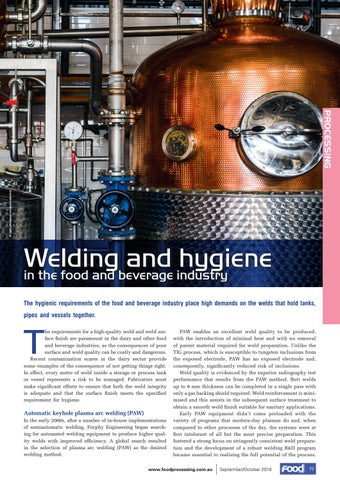Š stock.adobe.com/au/goodmanphoto
PROCESSING
Welding and hygiene in the food and beverage industry The hygienic requirements of the food and beverage industry place high demands on the welds that hold tanks, pipes and vessels together.
T
he requirements for a high-quality weld and weld surface finish are paramount in the dairy and other food and beverage industries, as the consequences of poor surface and weld quality can be costly and dangerous. Recent contamination scares in the dairy sector provide some examples of the consequence of not getting things right. In effect, every metre of weld inside a storage or process tank or vessel represents a risk to be managed. Fabricators must make significant efforts to ensure that both the weld integrity is adequate and that the surface finish meets the specified requirement for hygiene.
Automatic keyhole plasma arc welding (PAW) In the early 2000s, after a number of in-house implementations of semiautomatic welding, Furphy Engineering began searching for automated welding equipment to produce higher quality welds with improved efficiency. A global search resulted in the selection of plasma arc welding (PAW) as the desired welding method.
PAW enables an excellent weld quality to be produced, with the introduction of minimal heat and with no removal of parent material required for weld preparation. Unlike the TIG process, which is susceptible to tungsten inclusions from the exposed electrode, PAW has no exposed electrode and, consequently, significantly reduced risk of inclusions. Weld quality is evidenced by the superior radiography test performance that results from the PAW method. Butt welds up to 8 mm thickness can be completed in a single pass with only a gas backing shield required. Weld reinforcement is minimised and this assists in the subsequent surface treatment to obtain a smooth weld finish suitable for sanitary applications. Early PAW equipment didn’t come preloaded with the variety of programs that modern-day plasmas do and, when compared to other processes of the day, the systems were at first intolerant of all but the most precise preparation. This fostered a strong focus on stringently consistent weld preparation and the development of a robust welding R&D program became essential to realising the full potential of the process.
www.foodprocessing.com.au
September/October 2016
77
